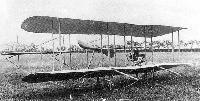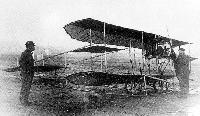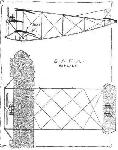J.Davilla, A.Soltan French Aircraft of the First World War (Flying Machines)
Caudron
The Caudron brothers (Rene and Gaston) were inspired by the Wright brothers' first flights in France in mid-1908. Their first design, the Type A, which was to have been powered by two engines, was, instead, flown as a glider because the engines were unavailable. The brothers then decided to produce a smaller aircraft which was intended to use a 25-hp Anzani engine. The Type A2 biplane had a pusher configuration with twin tail booms, twin fins and rudders, and used wing warping. These features would appear on many later Caudron designs even those with tractor-mounted engines. The Caudron A2 took to the air in 1909, its engine driving the propeller by a complicated chain transmission. As a result of troubles with the chain drive, the Caudron brothers repositioned the engine into tractor configuration to eliminate the need for a transmission drive. Thus modified, the aircraft, designated the Type A3, was more reliable and had better performance.
In 1910, the Caudrons established a training school at Ie Crotoy and an aircraft factory at Rue. The first aircraft to be produced at the factory was a 35-hp Anzani-powered tractor biplane designated the Type A4. It was controlled by a combination of wing warping and auxiliary surfaces mounted on the outer interplane struts. The pilot sat behind the rear spar of the lower mainplanes, where he was completely exposed to the elements.
The next Caudron design, the type B, featured a fuselage nacelle with a 70-hp Gnome or 60-hp Anzani engine in front and the pilot in back. This abbreviated fuselage/nacelle combination would also appear on many of the later Caudron aircraft. The Type B, although a tractor, retained features of the pusher layout; control was entirely by wing warping.
<...>
Показать полностью
L.Opdyke French Aeroplanes Before the Great War (Schiffer)
Deleted by request of (c)Schiffer Publishing
Caudron
Born in 1884, Rene Caudron grew up on a farm with his 2-year-older brother. Neither boy was interested in horses or in farming, but rather in the agricultural machinery of the farms around, and in bicycles and motorcycles. In 1908, out of the army and back on the farm, Rene heard of the Wrights, and he and his brother Gaston began in 1908 a big flying machine: the first Caudron was this 2-seat biplane finished in April 1909, designed for 2 small engines - one driving 2 tractor and the other 2 pusher propellers; but the engines did not arrive, and the project was given up and the airframe finished as a glider. Gaston mounted their horse Luciole and towed Rene in the glider some 10-15 m into the air.
(Wing area: 40 sqm; 2-30 hp Farcot engines)
Type A. No 1: The whole machine was redesigned smaller and lighter. A simple Anzani was now set on the lower wing beside the pilot, driving the pusher propeller through a chain. Wing-warping without ailerons, it flew, and was wrecked on its 9th flight. It was then rebuilt and modified, with the engine driving the pusher propeller directly, without chains. The tail booms ran back along the ground to a large tailplane and 2 small square rudders on top. It ran on 2 wheels fitted under the lower wing between the long forward skids.
(Span: 8 m; length: 8 m; wing area: 22 sqm; weight: 250 kg; speed: 98 kmh; 25 hp Anzani)
Type A. No 2: The 25 hp Anzani was now mounted on short struts above the lower wing in front of the pilot, driving the tractor propeller directly, without chains. Inteiplane ailerons were fitted. The modifications were made in May 1910, and the overall configuration set the shape of the many later and more successful Caudron designs of World War I. Variations included raising the engine almost to the level of the top wing, squared-off wingtips or curved ones. At least Nos 3 and 4 were also Type A.
Type Abis - perhaps including Nos 5-8 - was larger, with a 5-cylinder Anzani, and carried 1-2 people.
The Caudron firm became briefly associated with the firm SAFA (Societe Anonyme Francais d'Aviation), and the following designs were built under that name, partly sold to the school operated by CINA (Compagnie Internationale de Navigation Aerienne):
Type B: a 2-seat version of Type Abis, it was Caudron No 9, and served for a long time.
In 1911 Caudron became independent again, and the subsequent catalog describes Type A and also another Type B, a 2-3 seater touring biplane which appeared in January 1911; it was No 9. By the end of 1911 21 Caudrons had been built, including some new types, all with equal-span wings;
Показать полностью
Журнал Flight
Flight, September 24, 1910
ROUND-ABOUT FRENCH NOTES.
By OISEAU.
I HAD hoped to be able to give a detailed description this week of the S.A.F.A. biplane designed and piloted by M. Rene Caudron, but the intervention of Fate, in the form of a gusty wind, has, by upsetting and smashing the machine during a practice flight, made my desire impossible for the moment. But as M. Caudron was only very slightly hurt, it is probable that a new machine will be finished and in the air in the course of the next few days. A general impression of the appearance of the machine can be obtained from the photograph published in last week's FLIGHT. It will be observed that the skids themselves form the lower main members of the fuselage, two small wheels under the main plane raising them sufficiently from the ground to add to the ease of starting. The control is the almost universal Farman type of a hand-lever operating both the gauchissement ailerons and the elevator, and a foot-bar for steering. An Anzani five-cylinder motor is fitted.
The few flights I saw M. Caudron make on the S.A.F.A. were all quite excellent, and were very much faster than any other biplane that I have yet seen. The impression one gained from watching fairly closely was of the extreme sensitiveness of the control, the slightest movement of the elevator or ailerons being responded to immediately. I must say, however, that one rather expected disaster after watching M. Caudron's very pronounced banking as he took the corners, with the added danger of flying too low at the curves. But with more experience his performances will no doubt greatly improve. It is certainly pleasing to see a machine of such promise and to realise that in no way is it a copy of any other specific type.
<...>
Flight, December 31, 1910
AEROPLANE SILHOUETTES FROM THE PARIS SHOW.
THE S.A.F.A. BIPLANE.
FRENCH-BUILT biplane, designed by MM. Caudron Freres, and built at Paris-Plage, close to Boulogne.
General dimensions. - Span, 8 metres; length overall, 8 metres; carrying surface, 22 square metres.
Seating capacity. - One; a two-seater machine is also built, but this has a carrying surface of 32 square metres.
Engine. - Five-cylinder 40-li.p. Anzani. Gnome motors can also be fitted, and if water-cooled engines are preferred the Eole motors are supplied.
Propeller. - Two-bladed Normale propeller of 2.1 metres diameter, which is driven at 1,200 revs, per min.
Chassis. - The lower members of the main frame are continued forward and brought close to the ground so as to take the place of skids. Two wheels are also fitted to facilitate starting.
Tail. - A horizontal plane is mounted at the rear of the machine, the forward part of this plane is fixed but the latter edge is free so that it can be flexed to form an elevator. Above this plane are mounted twin rudders.
Lateral stability. - Maintained by two ailerons placed between the main planes as in the Curtiss machine. In another type of machine warping of the main planes is utilised as on the Wright biplane.
Weight. - In running order 220 kilogs.
Speed. - 75 kiloms. an hour.
System of control. - The warping of the rear elevator and the adjustment of the ailerons (or warping of the main planes, whichever is used) is controlled by a single lever worked by the pilot's left hand. The twin rear rudders are operated by a pedal while all the engine controls are so placed that they can be operated by the driver with his right hand.
Price. - With 5-cyl. 40-h.p. Anzani, 14,500 francs; with 50-h.p. Gnome, 22,000 francs; with 25-h.p. Eole motor, 12,500 francs. The two-seater machine with 40-h.p. Anzani engine costs 16,500 francs.
Показать полностью







